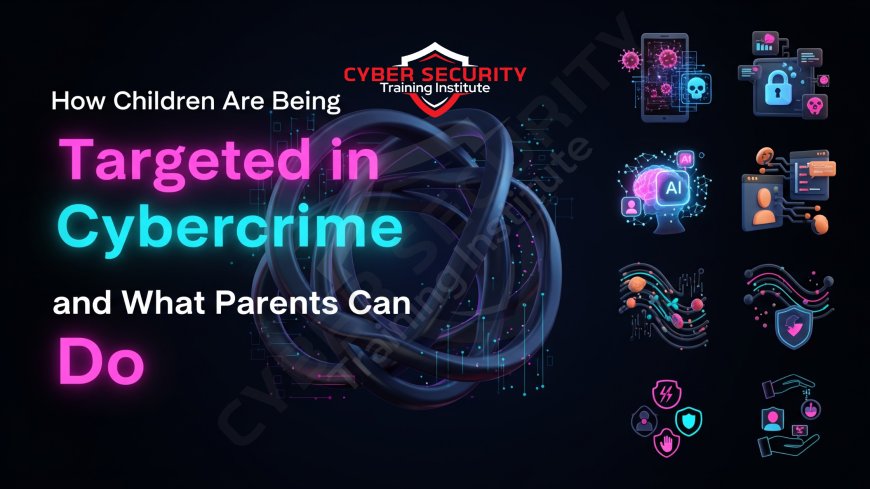How Children Are Being Targeted in Cybercrime and What Parents Can Do
In today’s digital age, children are growing up with unprecedented access to technology. From smartphones to gaming consoles, the internet is a playground for learning, socializing, and entertainment. However, this connected world also exposes kids to risks that many parents may not fully understand. Cybercriminals are increasingly targeting children, exploiting their curiosity, trust, and limited understanding of online dangers. As a parent, the thought of your child being a target can be overwhelming, but there’s plenty you can do to protect them. This blog post dives into the ways children are being targeted by cybercriminals, the types of threats they face, and practical steps parents can take to keep their kids safe online. Whether you’re tech-savvy or just getting started, this guide is designed to help you navigate the digital landscape with confidence.

Table of Contents
- Understanding the Threats: How Cybercriminals Target Children
- Common Cybercrime Tactics Aimed at Kids
- The Impact of Cybercrime on Children
- What Parents Can Do to Protect Their Kids
- Tools and Resources for Online Safety
- Conclusion
- Frequently Asked Questions
Understanding the Threats: How Cybercriminals Target Children
Children are particularly vulnerable to cybercrime because they’re often trusting and unaware of the risks lurking online. Cybercriminals exploit these traits, targeting kids through platforms they already use, like social media, gaming apps, and messaging services. Unlike adults, children may not recognize red flags, such as suspicious links or overly friendly strangers online.
According to a 2023 report by the Cybercrime Support Network, incidents of cybercrime targeting children have risen by 30% over the past five years. These crimes range from data theft to grooming and financial scams. The anonymity of the internet makes it easier for criminals to pose as peers, mentors, or even game developers to gain a child’s trust.
Common Cybercrime Tactics Aimed at Kids
Cybercriminals use a variety of tactics to target children. Here’s a breakdown of the most common ones:
| Tactic | Description | Example |
|---|---|---|
| Phishing | Tricking kids into sharing personal information through fake emails, texts, or websites. | An email claiming to be from a favorite game asking for login details to “unlock rewards.” |
| Grooming | Building trust with a child to exploit them emotionally or physically. | A stranger posing as a peer on social media to manipulate a child into sharing photos. |
| Malware | Software designed to harm devices or steal data, often disguised as games or apps. | A “free” game download that installs spyware on a child’s tablet. |
| In-Game Scams | Exploiting gaming platforms to steal money or account details. | A pop-up in a game offering free currency for entering credit card info. |
| Identity Theft | Stealing a child’s personal information to commit fraud. | Using a child’s name and birthdate from a hacked account to open fake accounts. |
Each of these tactics preys on a child’s curiosity or desire for rewards, making it critical for parents to stay informed.
The Impact of Cybercrime on Children
The effects of cybercrime on children can be profound and long-lasting. Beyond the immediate consequences, such as financial loss or stolen data, children may experience:
- Emotional Distress: Victims of grooming or cyberbullying may feel scared, ashamed, or isolated.
- Loss of Privacy: Stolen personal information can lead to identity theft or public exposure of private details.
- Financial Consequences: In-game scams or unauthorized purchases can drain family bank accounts.
- Trust Issues: Repeated exposure to scams can make children wary of technology or online interactions.
For example, a 2024 study by the National Center for Missing and Exploited Children found that 1 in 5 children who experienced online grooming reported symptoms of anxiety or depression. The emotional toll underscores the need for proactive parental involvement.
What Parents Can Do to Protect Their Kids
Protecting children from cybercrime doesn’t require you to be a tech expert. Here are practical steps you can take to create a safer online environment:
- Talk Openly About Online Safety: Have regular conversations with your kids about the risks of sharing personal information. Use age-appropriate examples, like explaining why they shouldn’t share their full name or address online.
- Set Clear Rules: Establish guidelines for device use, such as limiting screen time or restricting certain apps. For example, you might require that all app downloads be approved by you.
- Use Parental Controls: Most devices and platforms offer built-in tools to monitor and restrict online activity. For instance, Apple’s Screen Time and Google’s Family Link let you set app limits and block inappropriate content.
- Teach Critical Thinking: Help your child recognize suspicious behavior, like offers that seem too good to be true or strangers asking for personal details.
- Monitor Online Activity: Regularly check the apps and websites your child uses. You don’t need to invade their privacy, but staying aware of their digital habits can help you spot potential risks early.
- Secure Devices: Ensure all devices have updated antivirus software and strong passwords. Encourage kids to use unique passwords for each account and avoid reusing them.
- Educate Yourself: Stay informed about the latest cyber threats by following trusted resources like the Federal Trade Commission’s consumer protection website or Common Sense Media.
By combining open communication with practical tools, parents can empower their children to navigate the internet safely.
Tools and Resources for Online Safety
Technology can be a powerful ally in keeping kids safe online. Here are some tools and resources to consider:
- Parental Control Apps: Apps like Bark, Qustodio, or Net Nanny monitor social media, texts, and app activity, alerting you to potential dangers.
- Antivirus Software: Programs like Norton or McAfee protect devices from malware and phishing attacks.
- Educational Websites: Sites like Common Sense Media offer reviews of apps, games, and websites, along with age-appropriate recommendations.
- Reporting Platforms: Teach kids to report suspicious activity on platforms like Instagram, TikTok, or Roblox, which have built-in reporting tools.
- Hotlines: The CyberTipline by the National Center for Missing and Exploited Children (1-800-843-5678) allows you to report suspected online exploitation.
These tools, combined with active parental involvement, can significantly reduce your child’s risk of falling victim to cybercrime.
Conclusion
The internet is an incredible resource for children, offering opportunities for learning and connection. However, it also presents real risks, from phishing scams to online grooming. By understanding how cybercriminals target kids, recognizing the tactics they use, and taking proactive steps, parents can create a safer digital environment. Open communication, clear rules, and the right tools are key to protecting your child without stifling their online experience. Stay vigilant, keep learning, and empower your kids to explore the internet safely.
Frequently Asked Questions
What is cybercrime, and why are children targeted?
Cybercrime involves illegal activities conducted online, like stealing data or scamming people. Children are targeted because they’re often trusting and less aware of online risks.
How can I tell if my child is being targeted online?
Look for signs like secretive behavior, unexplained charges, or distress after using devices. Monitoring their online activity can help you spot issues early.
What is phishing, and how does it affect kids?
Phishing is when cybercriminals trick users into sharing personal info through fake messages or websites. Kids may fall for offers of free game items or rewards.
What is online grooming?
Grooming is when someone builds trust with a child to exploit them. It often happens on social media or gaming platforms.
How can I teach my child about online safety?
Talk regularly about not sharing personal info, avoiding suspicious links, and reporting strange messages. Use examples they can relate to, like gaming scams.
What are parental control apps?
These apps, like Bark or Qustodio, let you monitor and limit your child’s online activity, such as blocking harmful websites or tracking social media use.
Are free games safe for my child to play?
Not always. Some free games contain malware or scams. Check reviews on sites like Common Sense Media before allowing downloads.
How do I set up parental controls on my child’s device?
Most devices have built-in options, like Apple’s Screen Time or Google’s Family Link. Go to the device’s settings to enable restrictions and monitor usage.
What should I do if my child encounters a suspicious person online?
Tell them to stop communicating and report the person on the platform. You can also report to the CyberTipline at 1-800-843-5678.
Can cybercriminals steal my child’s identity?
Yes, if they get personal info like names or birthdates. This can lead to fraud, so monitor accounts and teach kids not to share sensitive details.
How can I secure my child’s devices?
Use strong, unique passwords, enable two-factor authentication, and install antivirus software like Norton or McAfee.
What is malware, and how does it get on my child’s device?
Malware is harmful software that can steal data or damage devices. It often comes from fake apps, games, or links kids click on.
Should I limit my child’s screen time?
Yes, setting limits reduces exposure to risks and encourages balance. Use parental control tools to enforce time restrictions.
How do I know if an app is safe for my child?
Check the app’s age rating, read reviews on trusted sites, and research the developer before allowing your child to use it.
What are in-game scams?
These are tricks within games, like fake offers for free currency, that steal money or account details. Teach kids to avoid pop-ups and unverified links.
Can social media be dangerous for kids?
Yes, social media can expose kids to grooming, cyberbullying, or scams. Set privacy settings to private and monitor their accounts.
How do I report cybercrime targeting my child?
Contact local authorities and report to the platform where the incident occurred. Use the CyberTipline for serious cases like grooming.
What’s the best way to monitor my child’s online activity?
Use parental control apps, check browsing history, and talk openly with your child about their online habits without invading their privacy.
Are there resources to learn more about online safety?
Yes, websites like Common Sense Media, the FTC’s consumer protection site, and the National Center for Missing and Exploited Children offer great advice.
How can I encourage my child to report suspicious activity?
Create a safe, non-judgmental environment where they feel comfortable sharing. Explain why reporting is important and praise them for being honest.
What's Your Reaction?
 Like
0
Like
0
 Dislike
0
Dislike
0
 Love
0
Love
0
 Funny
0
Funny
0
 Angry
0
Angry
0
 Sad
0
Sad
0
 Wow
0
Wow
0







![How to Install RHEL 10 on VMware/VirtualBox [Tutorial]](https://www.cybersecurityinstitute.in/blog/uploads/images/202509/image_430x256_68b56dc967a4a.jpg)








